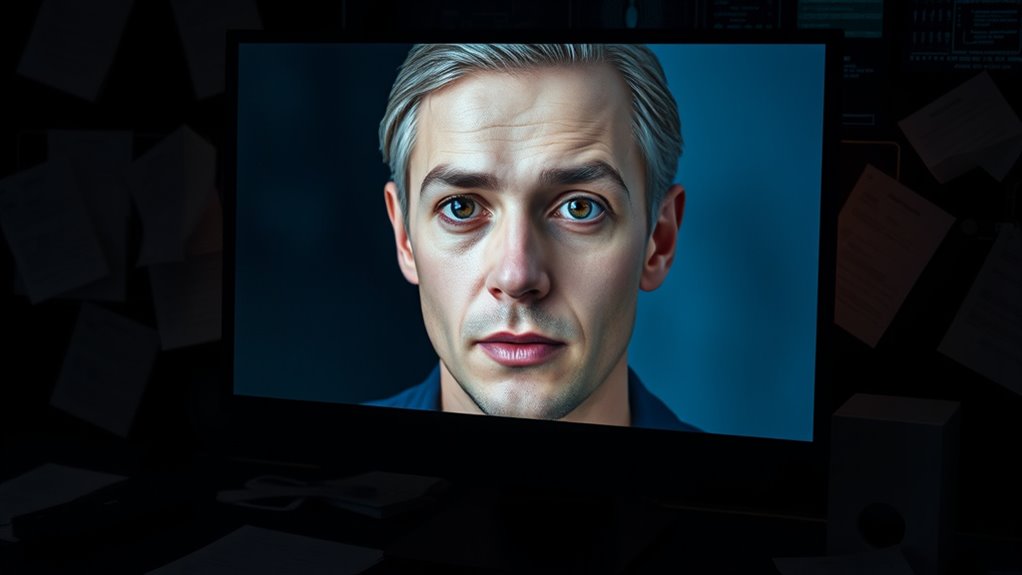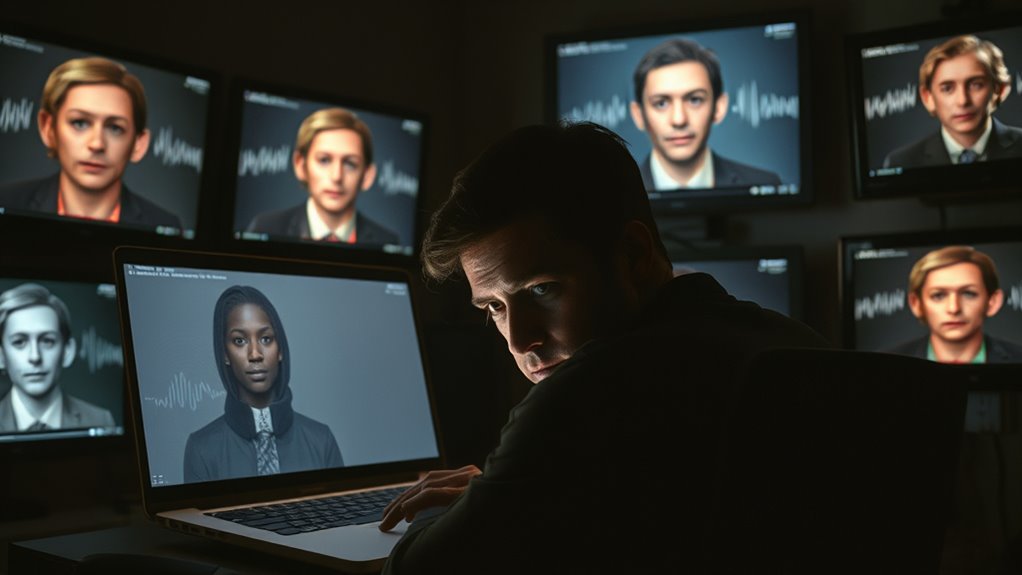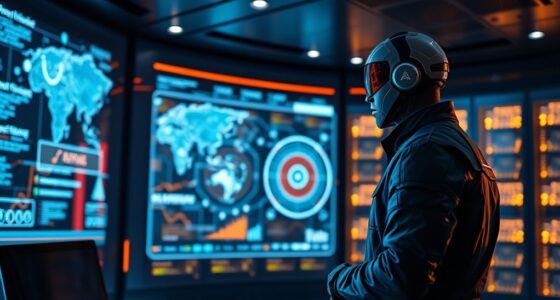To defend against deepfake impersonation attacks, stay vigilant and verify content through trusted sources before trusting voices or faces that seem suspicious. Look for signs like inconsistent lip sync, unnatural blinking, or strange lighting. Use detection tools and cross-reference videos or audio with official channels. Be cautious of sensational or out-of-context media, and educate yourself on deepfake tactics. If you want to understand more about safeguarding yourself from synthetic impersonations, keep exploring how detection methods and awareness can protect you.
Key Takeaways
- Use advanced detection tools and analyze videos for anomalies like mismatched lip movements or inconsistent lighting.
- Cross-verify suspicious content with trusted sources or official statements before sharing or acting.
- Educate yourself and others on deepfake signs and risks to recognize potential impersonation attempts.
- Stay updated on new deepfake technologies and detection methods to improve your defenses.
- Maintain skepticism of sensational or out-of-context videos, especially from unverified or unknown sources.

Deepfake impersonation attacks are a growing threat in today’s digital landscape, where advanced artificial intelligence techniques can create highly realistic videos of individuals saying or doing things they never actually did. These synthetic media can be used to spread false information, manipulate public opinion, or even blackmail victims. As someone steering through this environment, it’s crucial to understand how these attacks work and how you can defend yourself against them. Deepfakes leverage deep learning algorithms that analyze and mimic facial features, voice patterns, and mannerisms with astonishing accuracy. This technology can produce videos that are so convincing, you might find it hard to distinguish between real and fabricated content. Attackers often use deepfakes to impersonate public figures, colleagues, or loved ones, making it challenging to verify the authenticity of online videos or audio clips.
One of the first steps to protecting yourself is developing a healthy skepticism towards suspicious content. Before accepting a video or audio as genuine, consider the context and look for signs of manipulation. Pay attention to inconsistencies, such as mismatched lip movements, unnatural blinking, or strange shadows. Remember that even the most convincing deepfakes can sometimes contain subtle flaws that reveal their synthetic nature. Technology is also evolving to help combat this problem. Several companies and research groups are developing detection tools that analyze videos for signs of tampering, such as irregular pixel patterns, inconsistent lighting, or irregular audio-visual synchronization. These tools can help you identify deepfakes more reliably, especially when used alongside critical thinking.
Another effective approach involves verifying content through multiple sources. If you come across a video that seems shocking or out of character, look for corroboration from trusted news outlets or official channels. Be wary of sharing unverified content, as doing so can inadvertently spread misinformation. Additionally, staying informed about the latest deepfake techniques and detection methods can give you an edge in recognizing manipulated media. Many social media platforms are also implementing policies and tools to flag or remove deepfake content, but you should remain cautious and not rely solely on platform measures.
Finally, fostering digital literacy is essential. Educate yourself and others about the existence and risks of deepfake technology. Recognize that attackers may use these tools for various malicious purposes, from political sabotage to personal revenge. By remaining vigilant, verifying content through multiple channels, using detection tools, and cultivating a skeptical mindset, you can better defend yourself against the growing tide of deepfake impersonation attacks. Staying informed and cautious is your best armor in this rapidly evolving digital landscape.
Frequently Asked Questions
How Can Individuals Detect Deepfake Videos Easily?
To detect deepfake videos easily, start by closely observing the person’s facial features and movements for unnatural glitches or inconsistencies. Pay attention to blinking patterns, lip-sync accuracy, and background irregularities. Use available tools or apps designed to spot deepfakes, and verify videos with trusted sources. Trust your instincts—if something feels off, it’s worth researching further before accepting the video as real.
What Industries Are Most Vulnerable to Deepfake Impersonation Attacks?
Think of industries like politics, finance, and entertainment as sitting ducks for deepfake impersonation attacks. You’re most vulnerable here because fake videos and voices can manipulate opinions, steal identities, or spread misinformation rapidly. Attackers exploit these sectors’ trust and high-profile nature, making it easier to deceive the public or manipulate markets. Staying vigilant and implementing advanced detection tools are vital for protecting these industries from falling prey to malicious deepfakes.
Are There Legal Consequences for Creating Deepfake Content?
Yes, there are legal consequences for creating deepfake content. If you produce deepfakes that defame, deceive, or harm others, you could face criminal charges or civil lawsuits. Laws vary by jurisdiction, but many countries now have regulations addressing malicious deepfake use, especially for fraud, harassment, or misinformation. You should always consider the ethical and legal implications before creating or sharing synthetic media to avoid serious penalties.
How Effective Are Current Deepfake Detection Technologies?
Imagine you’re in a world where AI is as common as a smartphone. Current deepfake detection tools are fairly effective, but they aren’t foolproof — they catch most fakes, yet some still slip through. You should stay cautious, especially with unexpected videos or audio. While technology improves rapidly, combining AI detection with human judgment is your best bet for avoiding deception in today’s digital landscape.
Can Ai-Generated Deepfakes Be Used for Positive Purposes?
Yes, AI-generated deepfakes can be used for positive purposes. You might use them for realistic movie effects, educational content, or personalized virtual assistants. They allow you to create engaging experiences, enhance training simulations, or preserve loved ones’ memories in a respectful way. When used responsibly, deepfakes can foster innovation and creativity, making entertainment and communication more immersive and personalized without causing harm or deception.
Conclusion
To defend against deepfake deception, dedicate yourself to diligent detection and decisive decision-making. Stay alert to subtle signs, leverage layered security, and learn to recognize the lies woven into synthetic voices and faces. By embracing education, employing encryption, and evolving your defenses, you’ll empower yourself to prevent, protect, and prevail against these deceptive digital disguises. Don’t let dangerous deepfakes dominate—drive doubt away and defend your digital domain with determination and diligence.









